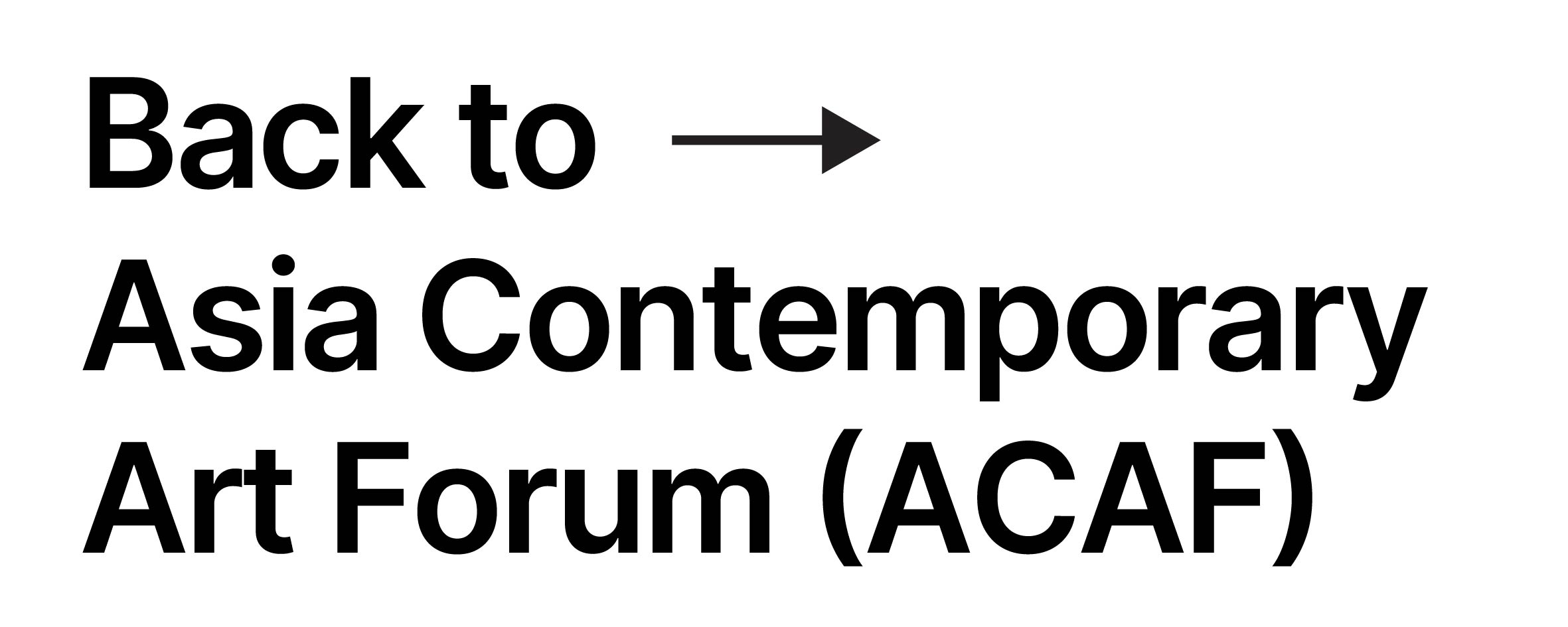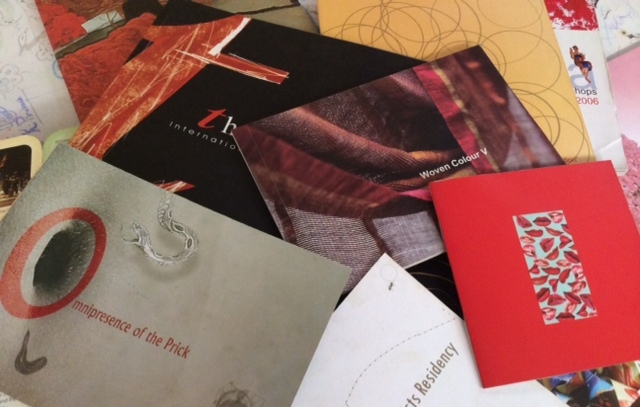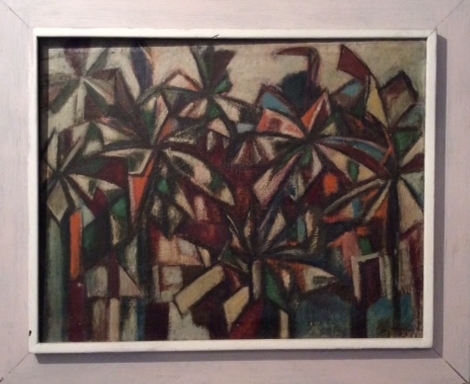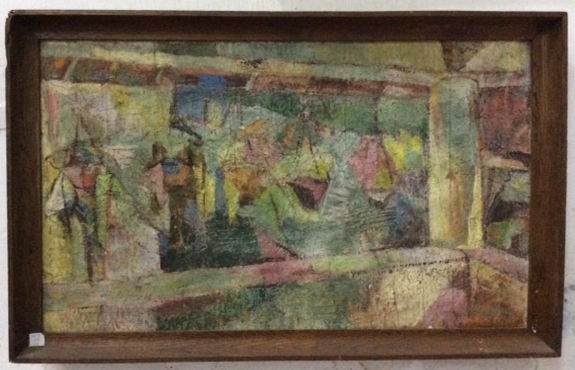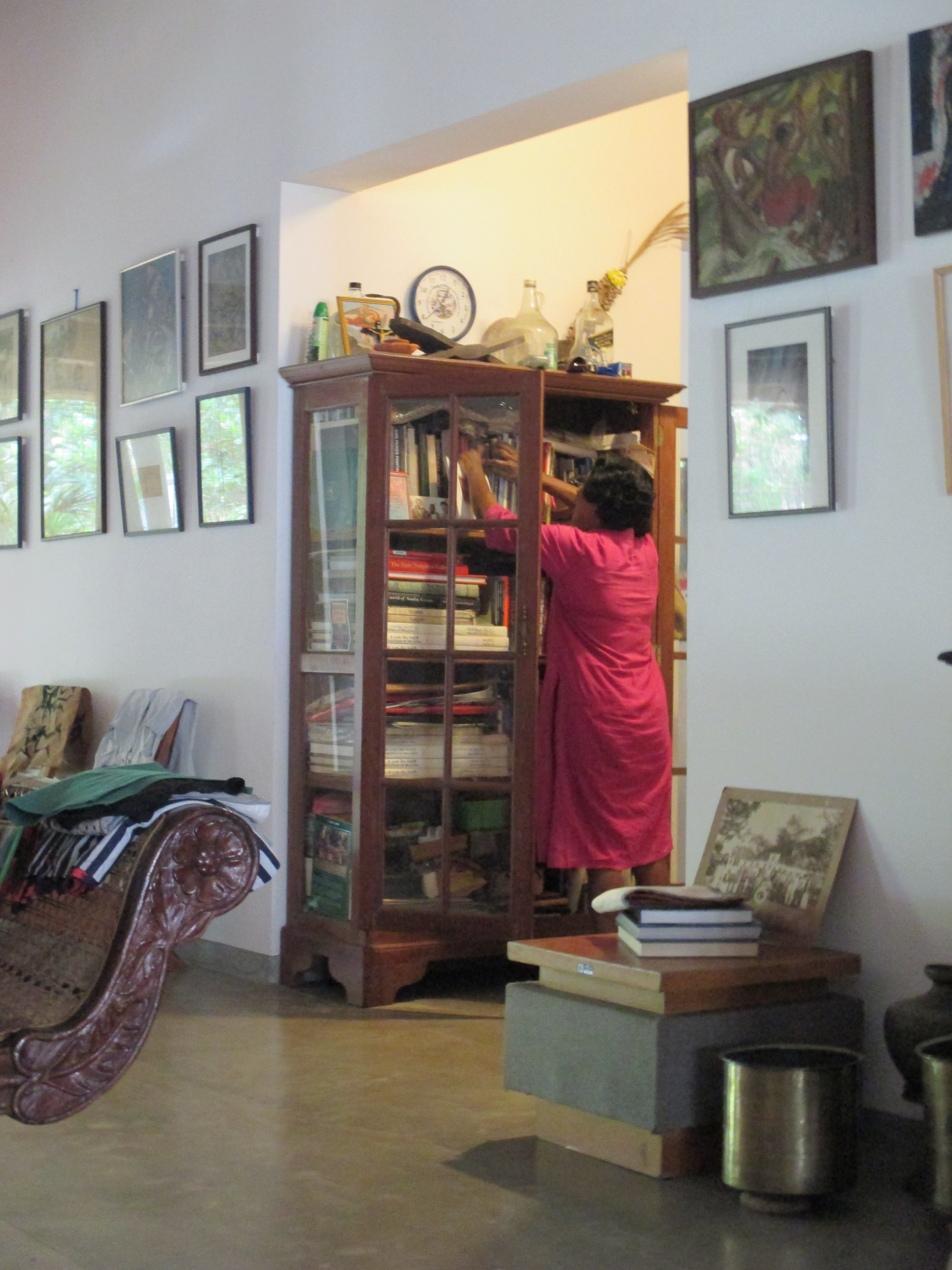FIELD REVIEW: South Asia
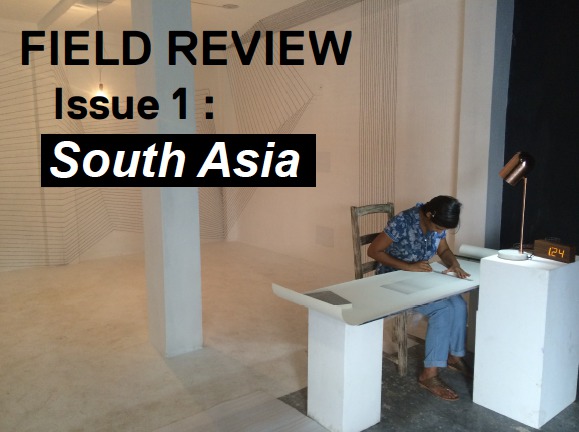
Introduction
Meenakshi Thirukode
______________________________________
Abstraction De-Constructed through the Lens of Post-Colonialism
Achia Anzi
Grasping at the Untold
Jyoti Dhar
Kumar Vaidya: Through the Lens of Erasure and Invisibility
Meenakshi Thirukode
Yasmin Jahan Nupur: Dancing in the Non-Spaces of Performance
Zeenat Nagree
The Poetics of Absence and Presence in Parul Gupta’s Art: A Case for Revisiting Theories and Histories of Abstraction
Somak Ghoshal
The Immediacy Of Rejection: Music, Curation, and Sincerity in New India
Rana Ghose
______________________________________
About the Author
Jyoti Dhar
is an art critic currently based in Colombo. Over the last decade, her focus has been on contemporary art from the Middle East and South Asia. She is a contributing editor for ArtAsiaPacific, a columnist for The Sunday Times in Sri Lanka and a contributor to Artforum. Dhar is the recipient of Forbes India’s ‘Emerging Art Writer of the Year’ award 2014. In New Delhi, she was critic-in-residence for “In Context II: public.art.ecology” with Khoj as well as rapporteur and editor of “City as Studio” programs 02 and 03 with Sarai. In Dubai, she curated the DIFC’s art collection, “In Decay” at Carbon 12 gallery and several exhibitions at Bagash Art Gallery.
Grasping at the Untold
Jyoti Dhar
A few months ago, I asked the respected artist, art historian and lecturer at the University of Jaffna, T. Shanaathanan what he thought of the state of art criticism in Sri Lanka. He simply replied, “We don’t even have the A, B, C of art history, so what to talk of art criticism?”[1] It’s a response worth reflecting on, when trying to write about artists from this topographically idyllic, ethnically diverse and politically fraught island; with a paradoxical 2000 year-old visual art history and nascent ‘contemporary art scene.’ Particularly in a place which has seen successive historical ruptures in the form of colonialism (Portuguese, Dutch and British) and civil war (1983-2009) – resulting in breaks of epistemic lineages and erasures of archival records – perhaps it is just as essential to chronicle as it is to critique.
When writing about art histories in South Asia, researching, documenting, analyzing and contextualizing generally goes hand in hand. What somewhat intensifies this experience in Sri Lanka, is the relative prominence of anecdotal evidence over academic art texts. This means that it can often feel like grasping in the dark, clutching at fragments, fleshing out the who, what and where of the artist, before even getting to the why and how. Exceptions to this include (largely biographical) material on the illustrious ’43 Group [2] , a group of nine affluent men, who unabashedly re-invented modernism within the Ceylonese context[3] . The next cultural legacy to be equally celebrated and disseminated is arguably that of architect Geoffrey Bawa, artist Barbara Sansoni, designer Ena De Silva and sculptor Laki Senanayake; a cohort that was active in newly independent Sri Lanka from the 1960s onward.
Somewhere in between and overlapping these two well-known groups – existing on the fringes of the ’43 Group, associated with the Melbourne Art Classes in the 1950s and central to the Young Artists’ Group (1957-76)[4] – are comparatively overlooked figures such as Sybil Keyt, Sita Kulasekara, Sushila Wijeyasuriya and Swanee Jayawardene. Having first come across these intriguing artists by accident, whilst reading an old copy of “Options” [5] magazine, it seemed like a fitting focal point from which to ask: In the face of fragmented resources, how do we best identify and contextualize the practice of artists who contributed to, and continued the lineages of, modernism in Sri Lanka [6] ? Who were the artists written into these canons and who were left out? How do we begin to problematize and plot courses through such knowns and unknowns?
In her exhibition “Reclaiming Histories: A Retrospective of Women’s Art,” (2000) [7] artist Anoli Perera brought to light the work of 40 women artists, including Keyt, Kulasekera, Wijeyasuriya and Jayawardene. Aptly held at the Sapumal Foundation, a former meeting ground of the modernist ’43 Group and Secretary Harry Pieris’s old home, Perera’s mighty endeavour sought to re-calibrate and unsettle our understanding of accepted and regurgitated positions on art in Sri Lanka. Spanning artists from the time of modernism to post-modernism, Perera likened the exhibition to a first “archeological dig.” [8] Sixteen years later seemed a decent distance from which to assess if there was any more information available on these artists, to delve deeper into their practice and explore how they may have influenced others.
In searching through the Sapumal Foundation, Women and Media Collective and Theertha International Artists’ Association archives – much of which is not digitized – it quickly became clear that many of the texts contained very similar material. Also, since the time of Perera’s pursuit, Kulasekera and Jayawardene have both passed away, octogenarian Keyt resides more in Australia and Wijeyasuriya limits public engagement. As such, there seemed to be less information available than before. However, conversations with practitioners including Jagath Weerasinghe, Chandragupta Thenuwara, Noeline Fernando, Anoli Perera, Channa Daswatte, Rohan De Soysa, Kumudini Samuel, Smriti Daniel, Menika van der Poorten and Sharmini Pereira proved generous and revelatory of some unexpected connections.
For example we know that Richard Gabriel, the last surviving member of the ’43 Group, was married to Kulasekera; a “quiet and unassuming” [9] artist trained at the Government College of Fine Arts in Madras. She was said to have made “restrained paintings” [10] such as “Figures by the Beach,” [11] using soft pastels, wood-cuts and oils. Less discussed, is that in 1949, Kulasekera was invited by Cora Abraham to start teaching at what was to become known as the Melbourne Art Classes.[12] These initially took place in a garage opposite ’43 Group member W J G Beling’s house and Ivan Peries also taught here.[13] The hallmark of these classes was said to be “freedom” [14] – in terms of discipline (e.g. painting, pottery and batik) and direction (harnessing the subconscious and borrowing from nature).
The Young Artists’ Group was born out of the Melbourne Art Classes, by former students such as Keyt and Jayawardene, and was started in 1957. Members would meet every Sunday in Abraham’s studio-home and go sketching to Colombo harbour and zoo as well as historical sites in Kandy, Anuradhapura and Matara. Keyt, who travelled a lot to India, was also interested in painting architectural buildings, Rajasthan landscapes and Mughal monuments. Jayawardene, on the other hand, was an artist, designer and teacher, who avidly experimented with batik techniques. One of the most striking paintings on display at the Sapumal foundation today, titled “Trees” and signed “1956,” is of her geometrically abstracted landscape of palm tree leaves, shards of light and white spaces.[15]
Jayawardene and Wijeyasuriya exhibited together in 1953, and off the back of that with the ’43 Group in 1954. Wijeyasuriya had attended St. Martin’s school of Art and was known for her supposedly “over-abstracted forms” and “solid draughtsmanship,”[16] as can be seen in her oil painting “Flower Sellers.” [17] Kulasekera also exhibited with the ’43 Group in London in 1952 and took part in several ad hoc studio exhibitions with them in 1962-4 alongside Neville Weeraratne and Keyt. Where it gets interesting is that Bawa had a close relationship with Keyt and Weeraratne, and would attend Abraham’s exhibitions. De Silva was also good friends with Abraham, whereas Senanayake spent time in her classes.[18] Therefore the Melbourne Art Classes seem to provide a link between these groups of modernists in the field of art, architecture, sculpture and design in 1940s-60s Sri Lanka.
However, what the conversations were between these key figures, or how this translated to the propulsion of modernist ideas at the time, is harder to ascertain. In the case of the ’43 Group, though little seems to be published or recorded about the theoretical positions they took, multiple examples of their work serve as insights into their practice and outlook.[19] Similarly, in the case of Bawa, Sansoni, Senanayake and De Silva, the island is littered with examples of their individual and collective projects.[20] However, in the case of those who fall in between histories, such as Kulasekera, Keyt, Jayawardene and Wijeyasuriya – what they were thinking or why they fell from prominence remain unanswered questions. Was it simply because they weren’t ‘radical or committed’ enough, as some have suggested?[21] Or was it more to do with the social conditions for women in art at the time?[22]
In looking back, how do we make sure not to overstate the position of things as they really were? And yet, how do we attempt to present the work of such figures through new lenses? For example, another key aspect that surfaces when trying to widen the scope and contextualize these artistic practices in relation to other disciplines, is that ‘the distinction between fine arts and applied arts’ was deeply ingrained during this era. [23] Though some fascinating examples of overlaps between modernist art and architecture in Sri Lanka do exist – such as that of architect Minnette De Silva [24] who cited Picasso, Henri Cartier-Bresson and George Keyt as key influences, or George Keyt himself who worked on the Gotami Vihara murals for architect Andrew Boyd in 1939 – it would be overreaching to situate these collaborations as ‘interdisciplinary.’[25]
Young Artists’ Group member Noeline Fernando tells us that later on Barbara Sansoni[26] was one of the first artists to break down such barriers between art and craft, and helped others to “broaden their outlook.” Today, many of these key stories, characters and moments are best explored through the memory of those such as Fernando – who can still be found teaching children art at the Sapumal Foundation. “We’re lucky we met them all,” she says. “They taught us there had to be a standard and substance to everything we did.” One is aware though, that as these artists continue to pass away, and their estates become increasingly dispersed, it will be even harder to piece together these narratives. At this point, instead of hastily drawing conclusions maybe we need to keep investing in asking questions, as T.Shanaathanan suggests, and accept that despite this, there will always be inevitable absences.
_____________________________________________________________________________
Bibliography
1. As part of redressing this, T. Shanaathanan made significant pedagogical changes to the art history department at the University of Jaffna in 2010. Chandragupta Thenuwara set up a similar department at the University of Visual and Performing Arts (UVPA) in Colombo to encourage budding art historians and critics, translating several critical texts into Sinhala and Tamil.
2. Books, accessible collections and public programs on them include Neville Weeratne’s “’43 Group: A Chronicle of Fifty Years in the Art of Sri Lanka,” (1993), the Sapumal Foundation in Colombo and The National Trust’s lecture by Rohan de Soysa on the ’43 Group on September 29th 2016, respectively.
3. The British Colonial name Ceylon was changed to Sri Lanka in 1972 when it became a republic.
4. Several different dates exist for the formation and dissolution of this group. The ones cited have been confirmed by former member Noeline Fernando.
5. The article “So and So’s Daughter, Sister, Wife and Mother,” by Robert Crusz, published in “Options,” 1st Quarter 2000, by the Women and Media Collective in Colombo, discusses the hidden legacies of women artists in Sri Lanka.
6. As the ’43 Group were the first to look at approaches such as surrealism and cubism, and engage with schools including Bauhaus and Visvabharati University, Shantiniketan, then re-interpret these ideas using local subjects, materials and traditions, it is impossible to de-link the history of abstraction from that of modernism in Sri Lanka.
7. Anoli Perera’s exhibition “Reclaiming Histories: A Retrospective Exhibition of Women’s Art,” (2000) was held in conjunction with Vaibhavi Academy of Fine Arts (VAFA) and Women in Visual Arts (WIVA).
8. Perera, A. Women Artists in Sri Lanka: Are they Carriers of a Woman’s Burden? Ed. Perera, S., South Asia Journal for Culture, Vol. 2, Colombo, 2008, Colombo Institute for the Advanced Study of Society and Culture and Theertha International Artists’ Collective.
9. Weereratne, N., “Remembering the quiet Sita Gabriel,” The Island newspaper, August 19 2001.
10. Weereratne, N., “’43 Group: A Chronicle of Fifty Years in the Art of Sri Lanka,” 1993, Melbourne, Lantana.
11. “Figures by the beach” (Pastel on board) is an undated painting on display at the Sapumal Foundation, gifted by Richard and Angelo Gabriel.
12. This was named after the street in which they took place, Melbourne Avenue in Bambalapitya, Colombo.
13. Ivan Peries and Justin Daraniyagala were apparently explorative of two different forms of abstraction and their commitment to these attitudes is said to have informed the practices of those such as Kulasekera and Wijesuriya.
14. Dhar, J., Fernando, N., Interview in September 2016.
15. Jayawardene was a pupil of Harry Pieris’s. She mysteriously lost all her pre-1970s work to an art dealer in Colombo. She later passed away in 2010.
16. Weereratne, N., The Sapumal Foundation Collection, A Select Catalogue, 2009, Colombo, The Sapumal Foundation. These remarks were made by ’43 Group member and cartoonist Aubrey Collette in response to work exhibited with the group in 1954.
17. “Flower Sellers,” Oil on Canvas, is an undated painting on display at the Sapumal Foundation in Colombo.
18. Weereratne, N., The Artist in Every Child, The Legacy of Cora Abraham, 2015, Colombo, Gunaratne. De Silva’s son, Anil Jayasuriya and Sansoni’s daughter-in-law, Nazreen Sansoni also later attended these classes.
19. Among factors that make the ’43 Group’s work distinct from other South Asian modernisms, is that it began earlier; though the group’s first formal meeting was in August 1943, experiments with modernism in Sri Lanka began in the 1930s, spurred by the exposure of artists such as Lionel Wendt to modernism in Europe in the 1920s.
20. A wonderful example of the four of them working together on a project is the Bentota Beach Hotel built in 1968.
21. Dhar, J., Weerasinghe, J. Interview in September 2016.
22.Ibid 6.
23. Dhar, J., Daswatte, C., Interview in September 2016.
24. Minnette De Silva is an intriguing character; the first women to attend Sir J J school of Architecture in Bombay; the first ‘Sri Lankan to build a modernist building in the country’ and the co-founder of Marg Magazine.
25. It was only much later that crossovers between art and craft, for example, were theoretically positioned by artists such as Anoli Perera. This is not to say, however, that modernists did not engage with other disciplines; Lionel Wendt was interested in Kandyan dancing; Beling was a trained architect and George Keyt was a poet and writer amongst other examples.
26. Sansoni created the commercially successful Barefoot concept in 1958, re-inventing handloom design into a ubiquitous hybrid style in Sri Lanka. She also made a number of architectural drawings for Geoffrey Bawa and went on numerous sketching trips with his brother and artist friend, Bevis Bawa and Donald Friend, respectively.

